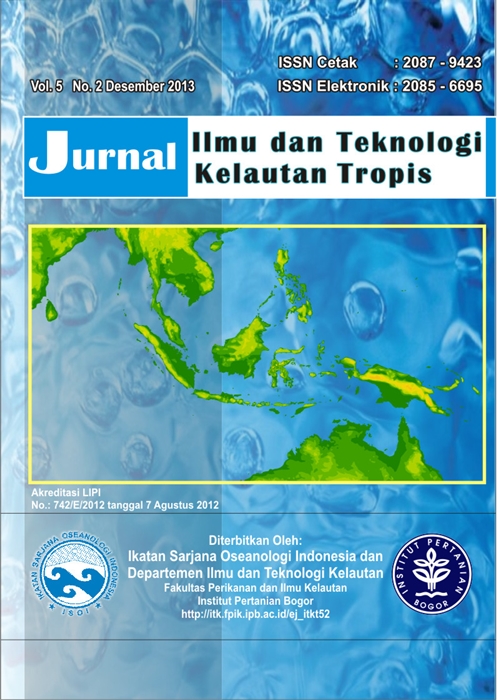WATER MASSCHARACTERISTICS OFWEDA BAY,HALMAHERA ISLAND, NORTH MALUKU
Abstract
The water quality parameters at 23 observation points in Weda Bay were collected using the Sea-Bird's Conductivity Temperature and Depth (CTD) 911 and Dissolved Oxygen (DO) meter ARO-USB 66 during Weda Expedition in 13 – 23 March 2013 (transition monsoon) with research vessel Baruna Jaya VII. The main goal of this research was to identify characteristics of water masses in Weda Bay. The results showed that the thickness of mixed layer in Weda Bay was about 40 m with the average levels of temperature, salinity, and oxygen at about 29.2 °C, 34.0, and 7.0 mg/L, respectively. Within thermocline layers, it was observed that there was the water type of Southern Subtropical Lower Water (SSLW) identified by the presence of salinity maximum above 35.0 occupied between 25.7 and 24.5 sigma-theta (16,2 °C < < 20,5 °C). Furthermore, there were oxygen homogenous layers at 5.1 mg/L situated at between 26 and 24.7 sigma-theta (15°C < < 20°C). In addition, oxygen inversion was found at 0.15 mg/L in the layer of between 26.8 and 26.0 sigma-theta (10°C < < 15°C). In the intermediate layer (>500 m), the temperature and salinity tended to be constant at 7.8 °C and 34.7, controlled by the sill separating Halmahera sea and Western North Pacific Ocean (WNPO). These water mass characteristics revealed the strong influences from WNPO to Weda Bay. The water, driven by Indonesian throughflow (ITF), flowed into Halmahera Sea before turned into Weda Bay.
Keywords: temperature, salinity, oxygen, SSLW, Weda bay
Authors
This work is licensed under a Creative Commons Attribution 4.0 International License.
Jurnal Ilmu dan Teknologi Kelautan Tropis i is an open-access journal, meaning that all content is freely available without charge to the user or their institution. Users are allowed to read, download, copy, distribute, print, search, or link to the full texts of the articles in this journal without needing to request prior permission from the publisher or the author.
All articles published by Jurnal Ilmu dan Teknologi Kelautan Tropis are licensed under the Creative Commons Attribution 4.0 International License. This allows for unrestricted use, distribution, and reproduction in any medium, provided proper credit is given to the original authors.
Authors submitting manuscripts should understand and agree that the copyright of published manuscripts is retained by the authors. Copyright encompasses the exclusive rights of authors to reproduce, distribute, and sell any part of the journal articles in all forms and media. Reproduction of any part of this journal, its storage in databases, and its transmission by any form or media is allowed without written permission from Jurnal Ilmu dan Teknologi Kelautan Tropis.


